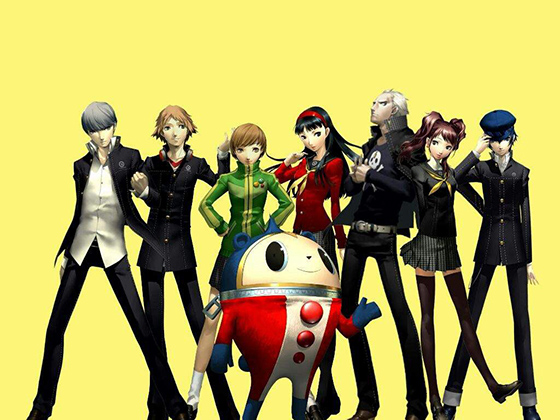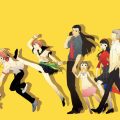Persona 4 Retrospective- A Decade of Reaching Out to the Truth

Persona 4 is a game that holds a very special place in my heart. It introduced me to the Shin Megami Tensei universe, the Persona series, and Atlus as a game developer. Before my introduction to this JRPG, I split my gaming time between Final Fantasy, Fire Emblem, and Xenosaga. For me Shin Megami Tensei: Persona 4 was a breath of fresh air. It was a JRPG that took place in a small town and told a wonderful story through its colorful, yet relatable cast. The overall message of being true to one’s self and accepting people for who they are hit me hard, especially when society tells us otherwise. Sure, there were supernatural elements such as summoning powerful psychic beings aka personas, and the protagonist ultimately being the play thing of a bored god. Even with the supernatural aspects of P4, I was pleasantly surprised and how little I missed common JRPG sci-fi and fantasy elements and tropes. I also found myself surprised at how much I enjoyed spending time on tasks that would be considered mundane, such as going to school, making friends, and solving people’s personal problems.
This week Persona 4 receives a final hurrah in the form of Persona Q2: New Cinema Labyrinth before firmly passing on the torch to the cast of Persona 5. To celebrate the release of PQ2 and P4 overall, a retrospective for one of my favorite games is only fitting.
Geoff actually wrote his own retrospective closer to the game’s ten year anniversary in December.

Persona 4 was released in North America on December 9, 2008 which wasn’t long after its July 10 release in Japan. In comparison, it took Atlus USA over a year to release Persona 3 in North America after its Japanese counterpart hit shelves in 2006. The development cycle from Persona 3 to 4 was relatively short at two years. Production on P4 didn’t begin until after P3 was completed. The game’s director, Katsura Hashino insisted that there would be no epilogue disc like with Persona 3: FES. Other important changes from P3 included the ability to directly control party members in battle, the replacement of moon cycles with weather cycles, a series of smaller dungeons, and the use of Japanese deities as personas opposed to the Greco-Roman gods. Elements such as creating social links, building social stats, and balancing the RPG elements within a social simulator were largely unchanged.
The game dropped well into the twilight years of the seventh generation of console gaming– big releases for the PlayStation 2 were uncommon. Despite releasing so late into the life of the PS2, Persona 4 did well. In its home country the game sold around 193,000 copies during the first week of sales. In North America the game was the best-selling PS2 game on Amazon for two weeks. In addition to great sales, Persona 4 was well-received among critics and garnered high scores. Even now it still has Metascore of 90 on Metacritic though its user score is a bit lower at 7.5.
At the time Atlus USA must have known they would have hit on their hands as the company planned a big release for the game. Original runs of the PS2 game were sold with the first half of the soundtrack. Meanwhile, the “Social Link Expansion Pack” contained the other half of the soundtrack, a 2009 calendar, a t-shirt, and a Teddie plush.
Despite the small town mystery-murder tone, Persona 4 never feels too heavy or depressing as an overall story—at least not until the end of the game. There are multiple endings that range from melancholy to happy, with a true ending. The true ending itself would have marked a fine end to this game, but given its popularity Atlus had more stories and adventures in mind for the Investigation Team. These adventures took the form of anime, manga, and more video games.

Manga Adaptations:
Persona 4 is written by Shuji Sogabe. These graphic novels originally started in September 2008 and are currently ongoing. The English localization is handled by Udon Entertainment and is easily found online.
The next entry in the adaptations list is the 2010 light novel written by Mamiya Natsuki, Persona x Detective Naoto which was never released outside of Japan, but has a fan translation. A few months later, a manga adaption drawn by Satoshi Shiki was also released, again only in Japan. The fact that Naoto Shirogane got her own spin-off isn’t surprising given her popularity.
Another character to receive a spin-off is Yosuke Hanamura, in a one-shot volume called Persona 4: The Magician penned by Shiichi Kukura in 2012. This release also stayed in Japan, but again can be read in English thanks to fan translations.

Anime Adaptations:
In 2012 Persona 4: The Animation was release on Japanese TV with an English simulcast on both Hulu and the now defunct Anime Network. Seiji Kishi directed the series and AIC A.S.T.A. handled the animation production. The anime plot largely followed the same story beats of the game, but played up more of the slice-of-life and humor aspects of the series. This is where the game’s protagonist was named Yu Narukami and made into a lovable weirdo.
Persona 4: The Animation -The Factor of Hope- is a recut of the anime series into an 86 minute movie by the same director and animation studio.
Persona 4: The Golden Animation is based on the Vita remake Persona 4 Golden. This series was animated by A-1 Pictures instead of AIC A.S.T.A. and released in 2014. While the animation itself is a little better, this adaptation/expansion to the original anime made little sense. It wasn’t meant for newcomers to the series and it seemed largely pointless if you already watched the first anime. In my opinion, it was a cash grab catered to fans of Golden, specifically Marie fans.

Video Game Remakes, Spin-offs, and Sequels:
Speaking of Persona 4 Golden, this 2012 Vita game was a remake of the PS2 title, done in a similar vein to the PSP’s Persona 3 Portable. In fact, this game was original planned as a PSP title, but development was shifted to the more powerful Vita. This allowed the development team to actually upscale the graphics, add new locations, new features such as network play, new story elements, and the ability to explore Inaba at night. New social links for Marie (a new character) and Tohru Adachi were also established. If that wasn’t enough, a new alternative ending was added. It was disappointing to some fans that the option to play as a female protagonist wasn’t available in this game like P3P, but the new features were a fair trade off.
The next big release in 2012 saw the franchise go in a slightly different direction. Altus and Arc System Works teamed up to create Persona 4 Arena, a 2D fighting game which also had heavy visual novel elements. This fighting game also saw much of the cast of Persona 3 returning, which effectively made it a sequel for both games. A robot named Labrys was the new original character introduced. The fighting game was well received among fans of the original and in the fighting games community.

After a two year break we had the release of Persona 4 Arena Ultimax, a direct sequel to Persona 4 Arena. Story-wise, it takes place a day after the events of Arena. The game actually debuted first in Japanese arcades in 2013 before coming to home consoles worldwide in 2014. Ultimax saw the rest of the Persona 3 SEES group (except for the protagonist) join the cast, with Adachi and Marie from Persona 4 now being playable. The new character for this game is Sho Minazuki, who is the behind the most of the events of this game. His backstory is actually tied to events in Persona 3. Gameplay wise, the characters have new moves and everyone was rebalanced. Additionally, every character was given a shadow counterpart with their own unique move sets.
The other 2014 release was Persona Q: Shadow of the Labyrinth, a first-person RPG dungeon crawler built on the Etrian Odyssey game engine. Unlike the Arena games, Q isn’t a sequel, but takes place during both the main events of P3 and P4 as an alternative side story. The new characters found within this story are Zen and Rei, who are playable. The game features EO-style dungeon exploration while battles are more like Persona games. In a neat throwback to pre-PS2 Persona titles, almost every character has the ability to use multiple personas. Because this game takes place between both series, the male protagonist from P3 is playable. Players can choose to see the game from the viewpoint of SEES or the Investigation Team.
By 2015 Persona fans were waiting for Persona 5, but we got one last push with the Investigation Team in the form of Persona 4: Dancing All Night. This Vita game is superficially similar to Hatsune Miku: Project DIVA with lots of visual novel elements serving as the game’s story mode. In the long Persona sequel timeline, it takes place after the epilogue of Persona 4: Golden where the cast helps out Rise Kujikawa as she plans her return to the idol industry. Things go awry and the power of dancing and friendship must save the day. I’d have more to say, but I vented my frustrations in a Summer Flame Day review written almost a year ago.

As Persona 4 heads into the sunset after a decade in the limelight, I fully expect Persona 5 and its cast to pick up the mantle. At times it’s hard to believe that P4 has been with us for a decade now. Other times, the series has felt like it has been milked to death. Fortunately, P4’s positives outweigh the negatives and this RPG series will retain its place in gaming history for decades to come.





